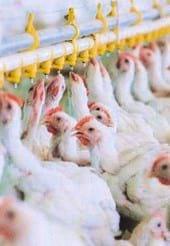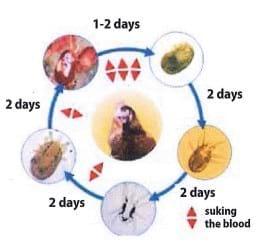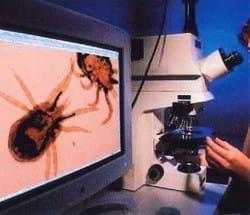Red Mite: Control, Combat and Eradicate
Published: February 24, 2014
By: Pier Enrico Rossi (Veterinary Surgeon) and Pier Ettore Lucchi(Ali-Avizoo)
Among the numerous ecto-parasites, the most widely recognized in the poultry industry is Dermanyssus gallinae, commonly known as “red mite”.
This parasite is not red, but greyish, and becomes red only when it is full of blood, after having feed on his victims. Demanyssus gallinae is quite important, both for his direct effects, being an obliged blood eater, and for his role in the transmission of various pathogens, viral and bacterial.
It is present worldwide, and inItalythe affected farms are estimated to be around 75-80% of total
In broiler farms the red mite does not pose a big problem, due to the very fast production cycle, while it represents a very big problem for layer flocks, due to the long production cycle of these animals and the structures internal to the buildings where they are grown.
These structures give red mites lots of opportunities to hide away from most of the treatments that can be applied in order to control them.
Likewisethe recent “new hens farming techniques” – enriched cages or aviaries – do not give any advantage against traditional cages or floor operations with regards to red mite control.
When the temperature starts to increase red mites appear in infested farms. During winter, in cold weather, they hide in any hole or crevice available, under slats, around doors & windows, in any dark place, as they are active during the night. Red mites can survive even if there are no animals in the building, they can fast from 6 months up to 1 year, and they do not die during winter – as many people think – but go into hibernation until the first warm temperatures, when they revive and start their vital cycle, and the resistance of their eggs to drying is very high.
 Half of their vital cycle is on the host, where they feed, and half in the environment, where they breed. In order to feed the red mite leaves its hidings, usually during the night, remains on his host for period between 30 and 60 minutes, then goes back in hiding. If the temperature is right the male mates with 3 or 4 females every day: the female then lays 10 to 15 eggs after each meal and the eggs hatch after 24 hours. The larvae can feed independently after 48 hours, and become adults in 6 to 7 days. The breeding cycle is at its maximum at 30°C with 70/80% relative moisture, while if ambient temperature rises above 35°C the colony starts declining.
Half of their vital cycle is on the host, where they feed, and half in the environment, where they breed. In order to feed the red mite leaves its hidings, usually during the night, remains on his host for period between 30 and 60 minutes, then goes back in hiding. If the temperature is right the male mates with 3 or 4 females every day: the female then lays 10 to 15 eggs after each meal and the eggs hatch after 24 hours. The larvae can feed independently after 48 hours, and become adults in 6 to 7 days. The breeding cycle is at its maximum at 30°C with 70/80% relative moisture, while if ambient temperature rises above 35°C the colony starts declining.Due to this fast reproductive cycle the red mite can multiply in a very short time out of proportion, and rapidly affect a whole flock.
Dermanyssus gallinae causes important disturbances to the hens, making them nervous and irritable, lose weight, eat less feed, produce less eggs: the economical damage can get up to 45 € cents per hen. Eggs are visibly affected, too, with small reddish-brown spots on the eggshell, due to mites’ blood and faeces; in young animals D.galline can cause a severe anaemia which occasionally can lead to death.
The control of red mite in farms is based almost exclusively on acaricides, a number of different molecules have shown activity against this parasite, by means of different modes of action, most inducing paralysis and death, but none of these molecules is registered in Italyagainst D.galline.
Only recently two products have been introduced: an organic-phosphorus compound based product – phoxim – and a spinosad based one.

Recent surveys have confirmed that farmers have always used and continue to use acaricides registered in agriculture or for other species of livestock, and the veterinary service has always tolerated the use of these acaricides in the poultry industry, however allowing their use exclusively between two production cycles and in the absence of animals.
But this improper use can produce
1) ineffectiveness of the molecules used and emergence of resistances
2) accumulation of pesticide residues in organs and tissues of poultry or eggs
The ideal acaricide should be able to reach all places where the red mite can hide, should have a prolonged efficacy, be harmless for the hosts, easy to apply, and rapidly active.
Moreover it should not be corrosive, have a short withdrawal period (preferably zero days) and, last but not least, be economical.
All this can be achieved by addressing the problem differently and more effectively.
It has been demonstrated that these parasites do not live on animals, but they go over them just to suck the blood. Olfactory sensors allow them to identify their potential guests: with the sense of smell, their most developed sense, they can identify the specific odours of birds.

With appropriate food supplements is now possible to reduce the stress caused to animals by infestation with D.galline. The use of medicinal plants such as Witamnia somnifera and Ocimum sanctum is able to reduce the plasma concentration of cortisol. Recent studies have shown that high blood levels of cortisol promote the growth of D.galline (Lucifer effect). The use of Mangifera indica, Mucuna pruriens and Boheravia diffusa, thanks to the presence of usolic acid, flavonoids and L-dopa, is capable of providing a response antioxidant, anti-inflammatory and immunomodulatory.
The synergy of these effects finally enables the animal to deal with the fight against D.gallinae.
The combination of these medicinal plants with Allium sativum, rich in allicin, allows to obtain the final answer against red mite.All the alkaloids described are found in the bloodstream, getting on one side the anti-stress effect, and the other side rendering the blood unattractive for the mite, which will be discouraged to continue to feed on the animal.
Additionally, the continued presence of these vegetable essences strengthens the immunity of the animal, while the continuous introduction of allicin in the environment causes an olfactory masking, “camouflaging” the smell of the bird and preventing mites from locating and reaching it.
As a last step the association of these plant essences to a suitably treated source of organic silica, non-absorbable in the intestine, will lead to the continuous elimination of this silica with the faeces.
With the drying of the faeces this silica is released as dust that in contact with the exoskeleton of D.gallinae, given its high abrasiveness, will fracture it, causing the death of the mite.
In this way we obtain several advantages, first of all no withdrawal time, and no problems of resistance are created by the treated silica. Last but not least we have a low cost, as the phyto-chemicals present and titrated in the product can replace methionine added to the feed additive.
Authors:
Recommend
Comment
Share
Truevet Animal Nutrition
28 de mayo de 2014
Though article is good but i am not convinved by alternative remedy suggested. we approach has to be directed against the mites. we should have a product which kills adult mites,larvae & eggs. In india, patented phytoacaridical technologies have been developed. such technologies have been successfully used in tick control & have yielded encourgaing results in red mite control.Such novel phytoacaricidal technologiues are based on biactive phytomiticides. these act on all life cycle stages of the red mite & is virtually a breakthough in sustainable mite amangement in poultry.
Recommend
Reply
Recommend
Reply
25 de febrero de 2014
Dear Pier,
Which product did you use against red mites? can we buy such product commercially?
Recommend
Reply

Would you like to discuss another topic? Create a new post to engage with experts in the community.










